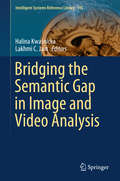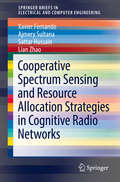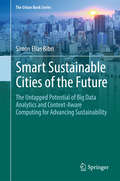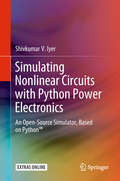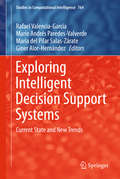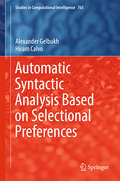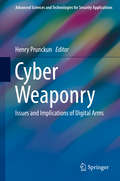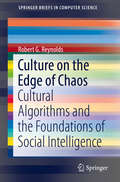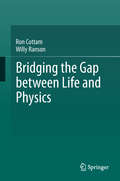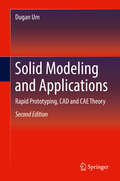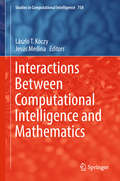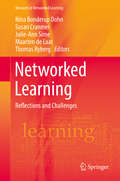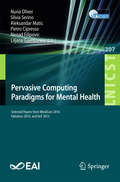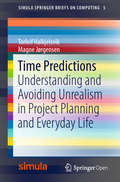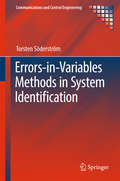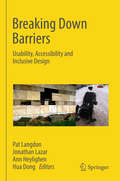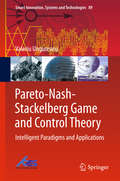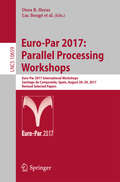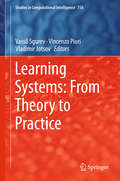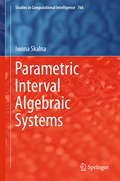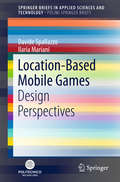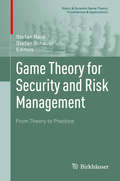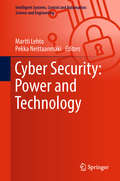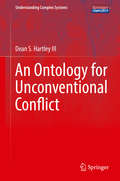- Table View
- List View
Bridging the Semantic Gap in Image and Video Analysis (Intelligent Systems Reference Library #145)
by Lakhmi C. Jain Halina KwaśnickaThis book presents cutting-edge research on various ways to bridge the semantic gap in image and video analysis. The respective chapters address different stages of image processing, revealing that the first step is a future extraction, the second is a segmentation process, the third is object recognition, and the fourth and last involve the semantic interpretation of the image.The semantic gap is a challenging area of research, and describes the difference between low-level features extracted from the image and the high-level semantic meanings that people can derive from the image. The result greatly depends on lower level vision techniques, such as feature selection, segmentation, object recognition, and so on. The use of deep models has freed humans from manually selecting and extracting the set of features. Deep learning does this automatically, developing more abstract features at the successive levels. The book offers a valuable resource for researchers, practitioners, students and professors in Computer Engineering, Computer Science and related fields whose work involves images, video analysis, image interpretation and so on.
Cooperative Spectrum Sensing and Resource Allocation Strategies in Cognitive Radio Networks (SpringerBriefs in Electrical and Computer Engineering)
by Lian Zhao Xavier Fernando Ajmery Sultana Sattar HussainCognitive radio networks (CRN) will be widely deployed in the near future, and this SpringerBrief covers some important aspects of it, as well as highlighting optimization strategies in Resource Allocation and Spectrum Sensing in CRNs. The cognitive approach in radio access is introduced in the first part of this SpringerBrief, and then next the benefits of cooperative spectrum sensing are highlighted and a framework for studying it under realistic channel conditions is described. New exact closed-form expressions for average false alarm probability and average detection probability are derived in this scenario. A novel approximation to alleviate the computational complexity of the proposed models are also discussed.Once the spectrum opportunities are identified, efficient and systematic resource allocation (RA) shall be performed. The second part of this SpringerBrief describes the taxonomy for the RA process in CRN. A comprehensive overview of the optimization strategies of the CRN RA is also provided. The device-to-device (D2D) communication scenario is discussed, then as a case study and various optimization strategies for the application of the CR technology in the D2D realm is studied. The application of advanced geometric water-filling (GWF) approach in CRN D2D environment for optimum resource allocation is presented in detail. Numerical results provide more insight quantitatively. Overall, this book is suitable for a wide audience that include students, faculty and researchers in wireless communication area and professionals in the wireless service industry.
Smart Sustainable Cities of the Future: The Untapped Potential Of Big Data Analytics And Context-aware Computing For Advancing Sustainability (The Urban Book Series)
by Simon Elias BibriThis book is intended to help explore the field of smart sustainable cities in its complexity, heterogeneity, and breadth, the many faces of a topical subject of major importance for the future that encompasses so much of modern urban life in an increasingly computerized and urbanized world. Indeed, sustainable urban development is currently at the center of debate in light of several ICT visions becoming achievable and deployable computing paradigms, and shaping the way cities will evolve in the future and thus tackle complex challenges.This book integrates computer science, data science, complexity science, sustainability science, system thinking, and urban planning and design. As such, it contains innovative computer–based and data–analytic research on smart sustainable cities as complex and dynamic systems. It provides applied theoretical contributions fostering a better understanding of such systems and the synergistic relationships between the underlying physical and informational landscapes. It offers contributions pertaining to the ongoing development of computer–based and data science technologies for the processing, analysis, management, modeling, and simulation of big and context data and the associated applicability to urban systems that will advance different aspects of sustainability.This book seeks to explicitly bring together the smart city and sustainable city endeavors, and to focus on big data analytics and context-aware computing specifically. In doing so, it amalgamates the design concepts and planning principles of sustainable urban forms with the novel applications of ICT of ubiquitous computing to primarily advance sustainability. Its strength lies in combining big data and context–aware technologies and their novel applications for the sheer purpose of harnessing and leveraging the disruptive and synergetic effects of ICT on forms of city planning that are required for future forms of sustainable development. This is because the effects of such technologies reinforce one another as to their efforts for transforming urban life in a sustainable way by integrating data–centric and context–aware solutions for enhancing urban systems and facilitating coordination among urban domains.This timely and comprehensive book is aimed at a wide audience across science, academia industry, and policymaking. It provides the necessary material to inform relevant research communities of the state–of–the–art research and the latest development in the area of smart sustainable urban development, as well as a valuable reference for planners, designers, strategists, and ICT experts who are working towards the development and implementation of smart sustainable cities based on big data analytics and context–aware computing.
Simulating Nonlinear Circuits with Python Power Electronics: An Open-Source Simulator, Based on Python™
by Shivkumar V. IyerThis book provides readers with an in-depth discussion of circuit simulation, combining basic electrical engineering circuit theory with Python programming. It fills an information gap by describing the development of Python Power Electronics, an open-source software for simulating circuits, and demonstrating its use in a sample circuit. Unlike typical books on circuit theory that describe how circuits can be solved mathematically, followed by examples of simulating circuits using specific, commercial software, this book has a different approach and focus. The author begins by describing every aspect of the open-source software, in the context of non-linear power electronic circuits, as a foundation for aspiring or practicing engineers to embark on further development of open source software for different purposes. By demonstrating explicitly the operation of the software through algorithms, this book brings together the fields of electrical engineering and software technology.
Exploring Intelligent Decision Support Systems: Current State and New Trends (Studies in Computational Intelligence #764)
by Rafael Valencia-García Giner Alor-Hernández Mario Andrés Paredes-Valverde María del Pilar Salas-ZárateThis book presents innovative and high-quality research regarding advanced decision support systems (DSSs). It describes the foundations, methods, methodologies, models, tools, and techniques for designing, developing, implementing and evaluating advanced DSSs in different fields, including finance, health, emergency management, industry and pollution control. Decision support systems employ artificial intelligence methods to heuristically address problems that are cannot be solved using formal techniques. In this context, technologies such as the Semantic Web, linked data, big data, and machine learning are being applied to provide integrated support for individuals and organizations to make more rational decisions. The book is organized into two parts. The first part covers decision support systems for industry, while the second part presents case studies related to clinical emergency management and pollution control.
Automatic Syntactic Analysis Based on Selectional Preferences (Studies In Computational Intelligence #765)
by Alexander Gelbukh Hiram CalvoThis book describes effective methods for automatically analyzing a sentence, based on the syntactic and semantic characteristics of the elements that form it. To tackle ambiguities, the authors use selectional preferences (SP), which measure how well two words fit together semantically in a sentence. Today, many disciplines require automatic text analysis based on the syntactic and semantic characteristics of language and as such several techniques for parsing sentences have been proposed. Which is better? In this book the authors begin with simple heuristics before moving on to more complex methods that identify nouns and verbs and then aggregate modifiers, and lastly discuss methods that can handle complex subordinate and relative clauses. During this process, several ambiguities arise. SP are commonly determined on the basis of the association between a pair of words. However, in many cases, SP depend on more words. For example, something (such as grass) may be edible, depending on who is eating it (a cow?). Moreover, things such as popcorn are usually eaten at the movies, and not in a restaurant. The authors deal with these phenomena from different points of view.
Cyber Weaponry: Issues And Implications Of Digital Arms (Advanced Sciences and Technologies for Security Applications)
by Henry PrunckunThere is little doubt that cyber-space has become the battle space for confrontations. However, to conduct cyber operations, a new armory of weapons needs to be employed. No matter how many, or how sophisticated an aggressor’s kinetic weapons are, they are useless in cyber-space. This book looks at the milieu of the cyber weapons industry, as well as the belligerents who use cyber weapons. It discusses what distinguishes these hardware devices and software programs from computer science in general. It does this by focusing on specific aspects of the topic—contextual issues of why cyber-space is the new battleground, defensive cyber weapons, offensive cyber weapons, dual-use weapons, and the implications these weapons systems have for practice. Contrary to popular opinion, the use of cyber weapons is not limited to nation states; though this is where the bulk of news reporting focuses. The reality is that there isn’t a sector of the political-economy that is immune to cyber skirmishes. So, this book looks at cyber weapons not only by national security agencies and the military, but also by law enforcement, and the business sector—the latter includes administrations termed non-government organisations (NGOs). This book offers study material suitable for a wide-ranging audience—students, professionals, researchers, policy officers, and ICT specialists.
Culture on the Edge of Chaos: Cultural Algorithms And The Foundations Of Social Intelligence (SpringerBriefs in Computer Science)
by Robert G. ReynoldsThe author first introduces the basic framework for cultural algorithms and he then explains the social structure of a cultural system as a mechanism for the distribution of problem-solving information throughout a population. Three different models for social organizations are presented: the homogeneous (nuclear family), heterogeneous (expanded family), and subculture (descent groups) social models. The chapters that follow compare the learning capabilities of these social organizations relative to problems of varying complexity. The book concludes with a discussion of how the results can impact our understanding of social evolution.
Game On! 2017: All The Best Games: Awesome Facts and Coolest Secrets
by Scholastic Imagine Publishing StaffGame On! 2017 is the second edition of this hot new annual! Features information and statistics about all of the most popular games, tips and tricks for gamers, and interviews from gaming's biggest personalities--including game developers and pro gamers! With the help of Imagine Publishing, learn how to dominate the biggest online multiplayer games and unlock the rarest trophies and achievements in different game worlds.
Bridging the Gap between Life and Physics
by Ron Cottam Willy RansonThis is the only book which deals with the correlatory comparison between hierarchical living systems and inorganic physical ones. The culmination of the book is the proposition of research to discover and understand the natural underlying level of organization which produces the descriptive commonality of life and physics. Traditional science eliminates life from its purview by its rejection of interrelationships as a primary content of systems. The conventional procedure of science is that of reductionism, whereby complex systems are dismantled to characterize lower level components, but virtually no attention is given to how to rebuild those systems—the underlying assumption is that analysis and synthesis are symmetrical. This book fulfills two main coupled functions. Firstly, it details hierarchy as the major formulation of natural complex systems and investigates the fundamental character of natural hierarchy as a widely transferable ‘container’ of structure and/or function – and this in the case of the new development of a representational or model hierarchy. Secondly, it couples this hierarchical description to that of the electronic properties of semiconductors, as a well-modeled canonical example of physical properties. The central thesis is that these two descriptions are comparable, if care is taken to treat logical and epistemological aspects with prudence: a large part of the book is composed of just this aspect of care for grounding consistency. As such great attention is given to correct assessment of argumentative features which are otherwise presumed ‘known’ but which are usually left uncertain. Development of the ideas is always based on a relationship between entity or phenomenon and their associated ecosystems, and this applies equally well to the consequent derivations of consciousness and information.
Solid Modeling and Applications: Rapid Prototyping, Cad And Cae Theory
by Dugan UmThis updated, second edition provides readers with an expanded treatment of the FEM as well as new information on recent trends in rapid prototyping technology. The new edition features more descriptions, exercises, and questions within each chapter. In addition, more in-depth surface theory has been introduced in section four, with particular emphasis in surface theory. Promising cutting edge technologies in the area of rapid prototyping are introduced in section seven, MATLAB-based FEM analysis has been added in section eight, and development of the plan stress and plane strain stiffness equations are introduced as a new chapter. Revised and updated based on student feedback, Solid Modeling and Applications: Rapid Prototyping, CAD and CAE Theory is ideal for university students in various engineering disciplines as well as design engineers involved in product design, analysis, and validation. It equips them with an understanding of the theory and essentials and also with practical skills needed to apply this understanding in real world design and manufacturing settings.
Interactions Between Computational Intelligence and Mathematics (Studies in Computational Intelligence #758)
by László T. Kóczy Jesús MedinaThis book presents recent research in the field of interaction between computational intelligence and mathematics, ranging from theory to applications. Computational intelligence, or soft computing consists of various bio-inspired methods, especially fuzzy systems, artificial neural networks, evolutionary and memetic algorithms. These research areas were initiated by professionals in various applied fields, such as engineers, economists, and financial and medical experts. Although computational intelligence offered solutions (at least quasi-optimal solutions) for problems with high complexity, vague and undeterministic features, initially little attention was paid to the mathematical models and analysis of the methods successfully applied. A typical example is the extremely successful Mamdani-algorithm, and its modifications and extensions, applied since the mid-1970s, where the first analysis of the simplest cases, showing why this algorithm was so efficient and stable, was not given until the early 1990s.Since the mid-2000s, the authors have organized international conferences annually to focus on the mathematical methodological issues in connection with computational intelligence approaches. These conferences have attracted a large number of submissions with a wide scope of topics and quality. The editors selected several high-quality papers and approached the authors to submit an essentially extended and improved book chapter based on the lectures.This volume is the first contributed book on the subject.
Networked Learning: Reflections And Challenges (Research in Networked Learning)
by Thomas Ryberg Maarten De Laat Nina Bonderup Dohn Susan Cranmer Julie-Ann SimeThe book is based on nine selected, peer-reviewed papers presented at the 10th biennial Networked Learning Conference (NLC) 2016 held in Lancaster. Informed by suggestions from delegates, the nine papers have been chosen by the editors (who were the Chairs of the Conference) as exemplars of cutting edge research on networked learning. Further reviews of all papers were conducted once they were revised as chapters for the book. The chapters are organized into two sections: 1) Situating Networked Learning: Looking Back - Moving Forward, 2) New Challenges: Designs for Networked Learning in the Public Arena. Further, we include an introduction which looks at the evolution of trends in Networked Learning through a semantic analysis of conference papers from the 10 conferences. A final chapter draws out perspectives from the chapters and discusses emerging issues. The book is the fifth in the Networked Learning Conference Series.
Pervasive Computing Paradigms for Mental Health: 4th International Symposium, Mindcare 2014, Tokyo, Japan, May 8-9, 2014, Revised Selected Papers (Lecture Notes of the Institute for Computer Sciences, Social Informatics and Telecommunications Engineering #100)
by Liljana Gavrilovska Silvia Serino Aleksandar Matic Pietro Cipresso Nenad Filipovic Nuria OliverThis book constitutes the refereed proceedings of the 6th International Symposium on Pervasive Computing Paradigms for Mental Health, MindCare 2016, held in Barcelona, Spain, in November 2016, and the Second International Conference of Future Access Enablers of Ubiquitous and Intelligent Infrastructures, Fabulous 2016, Belgrade, Serbia, October 24-26, 2016, and the Third International Conference on Interoperability in IoT, IIoT 2015, Rome, Italy, October 26-27, 2015. The 24 papers were selected from 32 submissions. MindCare presents technologies in favor of maintaining and improving psychological well-being. Fabulous presents broad areas of future wireless networks, ambient and assisted living and smart infrastructures in order to interact, exchange ideas, expertise, experience and know-how. And finally IIoT presents tools and services in home automation and industrial service.
Time Predictions: Understanding And Avoiding Unrealism In Project Planning And Everyday Life (Simula Springerbriefs On Computing Ser. #5)
by Torleif Halkjelsvik Magne JørgensenThis book is published open access under a CC BY 4.0 license.Predicting the time needed to complete a project, task or daily activity can be difficult and people frequently underestimate how long an activity will take. This book sheds light on why and when this happens, what we should do to avoid it and how to give more realistic time predictions. It describes methods for predicting time usage in situations with high uncertainty, explains why two plus two is usually more than four in time prediction contexts, reports on research on time prediction biases, and summarizes the evidence in support of different time prediction methods and principles. Based on a comprehensive review of the research, it is the first book summarizing what we know about judgment-based time predictions. Large parts of the book are directed toward people wishing to achieve better time predictions in their professional life, such as project managers, graphic designers, architects, engineers, film producers, consultants, software developers, or anyone else in need of realistic time usage predictions. It is also of benefit to those with a general interest in judgment and decision-making or those who want to improve their ability to predict and plan ahead in daily life.
Errors-in-Variables Methods in System Identification (Communications and Control Engineering)
by Torsten SöderströmThis book presents an overview of the different errors-in-variables (EIV) methods that can be used for system identification. Readers will explore the properties of an EIV problem. Such problems play an important role when the purpose is the determination of the physical laws that describe the process, rather than the prediction or control of its future behaviour. EIV problems typically occur when the purpose of the modelling is to get physical insight into a process. Identifiability of the model parameters for EIV problems is a non-trivial issue, and sufficient conditions for identifiability are given. The author covers various modelling aspects which, taken together, can find a solution, including the characterization of noise properties, extension to multivariable systems, and continuous-time models. The book finds solutions that are constituted of methods that are compatible with a set of noisy data, which traditional approaches to solutions, such as (total) least squares, do not find. A number of identification methods for the EIV problem are presented. Each method is accompanied with a detailed analysis based on statistical theory, and the relationship between the different methods is explained. A multitude of methods are covered, including: instrumental variables methods; methods based on bias-compensation; covariance matching methods; and prediction error and maximum-likelihood methods. The book shows how many of the methods can be applied in either the time or the frequency domain and provides special methods adapted to the case of periodic excitation. It concludes with a chapter specifically devoted to practical aspects and user perspectives that will facilitate the transfer of the theoretical material to application in real systems. Errors-in-Variables Methods in System Identification gives readers the possibility of recovering true system dynamics from noisy measurements, while solving over-determined systems of equations, making it suitable for statisticians and mathematicians alike. The book also acts as a reference for researchers and computer engineers because of its detailed exploration of EIV problems.
Breaking Down Barriers: Usability, Accessibility and Inclusive Design
by Jonathan Lazar Pat Langdon Ann Heylighen Hua DongThe Cambridge Workshops on Universal Access and Assistive Technology (CWUAAT) is one of the few gatherings where people interested in inclusive design, across different fields, including designers, computer scientists, engineers, architects, ergonomists, ethnographers, policymakers and user communities, meet, discuss, and collaborate. CWUAAT has also become an international workshop, representing diverse cultures including Portugal, Germany, Trinidad and Tobago, Canada, Australia, China, Norway, USA, Belgium, UK, and many more. The workshop has five main themes based on barriers identified in the developing field of design for inclusion: I Breaking Down Barriers between Disciplines II Breaking Down Barriers between Users, Designers and Developers III Removing Barriers to Usability, Accessibility and Inclusive Design IV Breaking Down Barriers between People with Impairments and Those without V Breaking Down Barriers between Research and Policy-making In the context of developing demographic changes leading to greater numbers of older people and people living with impairments, the general field of inclusive design research strives to relate the capabilities of the population to the design of products, services, and spaces. CWUAAT has always had a successful multidisciplinary focus, but if genuine transdisciplinary fields are to evolve from this, the final barriers to integrated research must be identified and characterised. Only then will benefits be realised in an inclusive society. Barriers do not arise from impairments themselves, but instead, are erected by humans, who often have not considered a greater variation in sensory, cognitive and physical user capabilities. Barriers are not only technical or architectural, but they also exist between different communities of professionals. Our continual goal with the CWUAAT workshop series is to break down barriers in technical, physical, and architectural design, as well as barriers between different professional communities.
Pareto-Nash-Stackelberg Game and Control Theory: Intelligent Paradigms And Applications (Smart Innovation, Systems And Technologies #89)
by Valeriu UngureanuThis book presents a comprehensive new, multi-objective and integrative view on traditional game and control theories. Consisting of 15 chapters, it is divided into three parts covering noncooperative games; mixtures of simultaneous and sequential multi-objective games; and multi-agent control of Pareto-Nash-Stackelberg-type games respectively. Can multicriteria optimization, game theory and optimal control be integrated into a unique theory? Are there mathematical models and solution concepts that could constitute the basis of a new paradigm? Is there a common approach and method to solve emerging problems? The book addresses these and other related questions and problems to create the foundation for the Pareto-Nash-Stackelberg Game and Control Theory. It considers a series of simultaneous/Nash and sequential/Stackelberg games, single-criterion and multicriteria/Pareto games, combining Nash and Stackelberg game concepts and Pareto optimization, as well as a range of notions related to system control. In addition, it considers the problems of finding and representing the entire set of solutions. Intended for researches, professors, specialists, and students in the areas of game theory, operational research, applied mathematics, economics, computer science and engineering, it also serves as a textbook for various courses in these fields.
Euro-Par 2017: Euro-par 2017 International Workshops, Santiago De Compostela, Spain, August 28-29, 2017, Revised Selected Papers (Lecture Notes in Computer Science #10659)
by Luc Bougé Dora B. HerasThis book constitutes the proceedings of the workshops of the 23rd International Conference on Parallel and Distributed Computing, Euro-Par 2017, held in Santiago de Compostela. Spain in August 2017. The 59 full papers presented were carefully reviewed and selected from 119 submissions.Euro-Par is an annual, international conference in Europe, covering all aspects of parallel and distributed processing. These range from theory to practice, from small to the largest parallel and distributed systems and infrastructures, from fundamental computational problems to full-edged applications, from architecture, compiler, language and interface design and implementation to tools, support infrastructures, and application performance aspects.
Learning Systems: From Theory to Practice (Studies In Computational Intelligence #756)
by Vincenzo Piuri Vassil Sgurev Vladimir JotsovBy presenting the latest advances in fuzzy sets and computing with words from around the globe, this book disseminates recent innovations in advanced intelligent technologies and systems. From intelligent control and intuitionistic fuzzy quantifiers to various data science and industrial applications, it includes a wide range of valuable lessons learned and ideas for future intelligent products and systems.
Parametric Interval Algebraic Systems (Studies in Computational Intelligence #766)
by Iwona SkalnaThis self-contained book presents a framework for solving a general class of linear systems with coefficients being continuous functions of parameters varying within prescribed intervals. It also provides a comprehensive overview of the theory related to solving parametric interval linear systems and the basic properties of parametric interval matrices. In particular, it develops several new algorithms delivering sharp rigorous bounds for the solutions of such systems with full mathematical rigor. The framework employs the arithmetic of revised affine forms that enables the readers to handle dependent data. The book is intended not only for researchers interested in developing rigorous methods of numerical linear algebra, but also for engineers dealing with problems involving uncertain data. The theory discussed is also useful in various other fields of numerical analysis, in computer graphics, economics, computational geometry, computer-aided design, computer-assisted proofs, computer graphics, control theory, solving constraint satisfaction problems, and global optimization.
Location-Based Mobile Games: Design Perspectives (SpringerBriefs in Applied Sciences and Technology)
by Davide Spallazzo Ilaria MarianiThis book approaches Location Based Mobile Games from a design perspective, investigating the peculiar traits that make them compelling contemporary practices and challenging fields of investigation. Relying on an interdisciplinary theoretical background and empirical studies, it delves into LBMGs’ intertwining theoretical assumptions and describes their translation into practice. The authors examine these games from different perspectives, exploring how they can impact the way we look at our surroundings, their influence on our social dimension, their ability to translate a wide range of information into a game experience, and the negotiations they activate by intertwining two realities. Each issue is addressed from a twofold perspective: that of the designers who craft the games, and that of the users who interpret the designers’ choices and take part in the game experience. In so doing, the book covers the relationship between processes of designing and playing, investigating games that communicate through meaningful interactions, share perspectives as forms of narratives, and integrate physicality and surroundings in the play activity. The reasoning advanced throughout the chapters will benefit researchers, designers and entrepreneurs in the field, as it provides a novel perspective on LBMGs, seeks to increase designers’ awareness of often-neglected issues, and suggests interpretations and practices that can impact how commercial games are designed.
Game Theory for Security and Risk Management: From Theory to Practice (Static & Dynamic Game Theory: Foundations & Applications)
by Stefan Rass Stefan SchauerThe chapters in this volume explore how various methods from game theory can be utilized to optimize security and risk-management strategies. Emphasizing the importance of connecting theory and practice, they detail the steps involved in selecting, adapting, and analyzing game-theoretic models in security engineering and provide case studies of successful implementations in different application domains. Practitioners who are not experts in game theory and are uncertain about incorporating it into their work will benefit from this resource, as well as researchers in applied mathematics and computer science interested in current developments and future directions.The first part of the book presents the theoretical basics, covering various different game-theoretic models related to and suitable for security engineering. The second part then shows how these models are adopted, implemented, and analyzed. Surveillance systems, interconnected networks, and power grids are among the different application areas discussed. Finally, in the third part, case studies from business and industry of successful applications of game-theoretic models are presented, and the range of applications discussed is expanded to include such areas as cloud computing, Internet of Things, and water utility networks.
Cyber Security: Power and Technology (Intelligent Systems, Control and Automation: Science and Engineering #93)
by Pekka Neittaanmäki Martti LehtoThis book gathers the latest research results of scientists from different countries who have made essential contributions to the novel analysis of cyber security. Addressing open problems in the cyber world, the book consists of two parts. Part I focuses on cyber operations as a new tool in global security policy, while Part II focuses on new cyber security technologies when building cyber power capabilities. The topics discussed include strategic perspectives on cyber security and cyber warfare, cyber security implementation, strategic communication, trusted computing, password cracking, systems security and network security among others.
An Ontology for Unconventional Conflict (Understanding Complex Systems)
by Dean S. HartleyThis book describes the ontology structure, types of actors, their potential actions, and ways that actions can affect the things that are part of the conflict. An ontology of unconventional conflict supports the understanding of unconventional conflict in general. It also provides a tool for understanding and investigating a particular unconventional conflict. The ontology specifies the relations among the elements and supports creating a description of a particular situation. Unconventional conflict spans the range from natural disasters through human disagreements to irregular warfare (up to conventional war). Unconventional conflict involves damage to things and injuries to people; however, the critical factors are the actions, reactions, and opinions of people, including political, military, economic, social, infrastructure, and information components. This ontology supports and will appeal to military strategists, political scientists, economists, and politicians in understanding their planning for, and managing of these conflicts.
